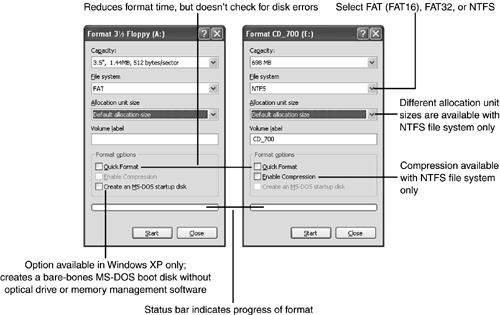Using Format with Floppy and Hard Disks
| < Day Day Up > |
| Format works in very different ways, depending on whether it is used on a hard or floppy disk. When Format is used on a hard drive, it creates a master boot record, two file allocation tables, and a root directory (also referred to as the root folder ). The rest of the drive is checked for disk surface errors ”any defective areas are marked as bad to prevent their use by the operating system. Format appears to "destroy" the previous contents of a hard disk, but if you use Format on a hard disk by mistake, Norton Utilities and some other programs can be used to unformat the drive and enable you to recover most, or even all, your information because most of the disk surface is not changed by Format.
If a floppy disk is prepared with Format and the unconditional /U option is used from the command line, or the Windows Explorer Full Format option is used, sector markings (a sector equals 512 bytes) are created across the surface of the floppy disk before other disk structures are created, destroying any previous data on the disk. If the Quick Format or Safe Format option is used, the contents of the disk are marked for deletion but can be retrieved with Norton Utilities or Norton System Works. For more information about using Format with hard drives , see Tables 15.5 and 15.6. For more information about using Format with floppy disks, see Table 15.7. A floppy disk can be only a single drive letter, but a hard disk can be subdivided into one or more drive letters . Every drive letter created by Fdisk must be formatted. Using Format with Floppy DrivesAlthough most floppy disks today are preformatted at the factory, Format is still useful as a means to
Table 15.7 covers the most important different Format options that apply to floppy disks. For additional Format options available with some versions of Windows, open a command-prompt window, type Format /? , and press Enter. Table 15.7. Major Format Options for Floppy Drives
Formatting Floppy and Hard Disks with Windows ExplorerWindows Explorer can be used to format both hard drives and floppy disks. Right-click the drive you want to format, select Format, and the Format options are displayed, as in Figures 15.17 and 15.18. Figure 15.17. The Windows 9x Explorer Format menu enables the user to select the same options that can be used with the command-line Format program, and also provides an alternative to the Sys command. Figure 15.18. The Windows XP Explorer Format menu for a floppy disk (left) and hard disk (right). Windows 2000 doesn't offer the Make an MS-DOS Startup Disk option, but is otherwise similar. tip
The Windows Me Explorer Format has some of these same options, but lacks the option to create a bootable floppy. To create a bootable floppy with Windows Me, create an emergency startup disk, or copy the command.com and io.sys files from the \Windows\Command\EBD folder to a blank, formatted floppy disk. The Windows XP Explorer Format options for floppy disk and hard disk can be seen in Figure 15.18. (Windows 2000's options are almost identical, except for the lack of the MS-DOS startup disk option.) | ||||||||||||||||||||||||||||||||||||||||
| < Day Day Up > |
EAN: N/A
Pages: 310

